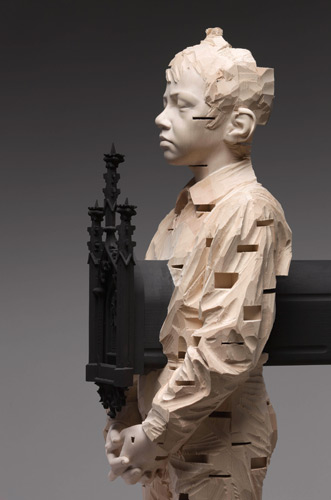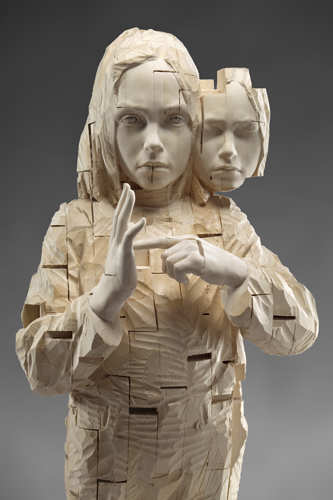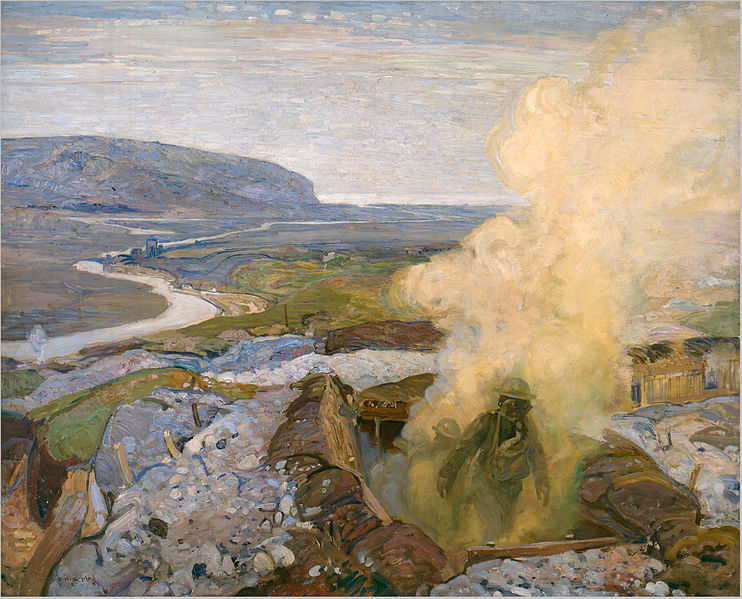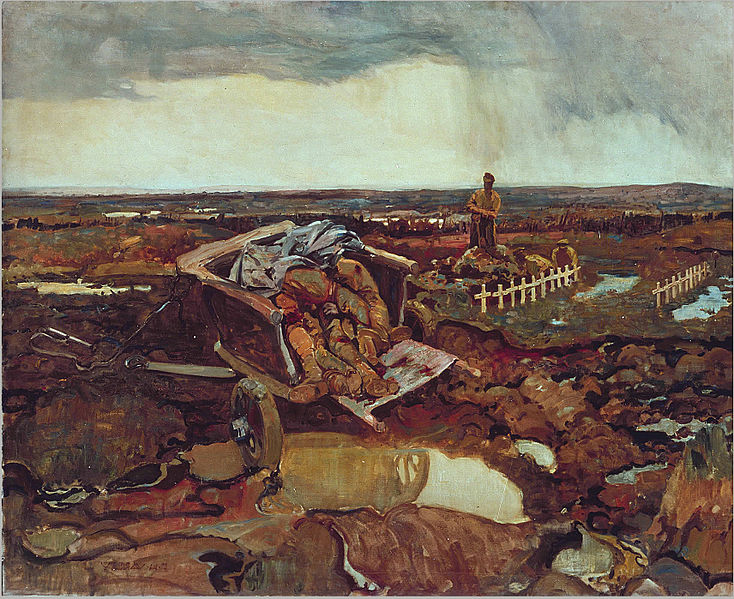Well, I guess I’m over my flu or whatever… staying up way too late on a school night, doodling in my sketchbook. Remnants of fevered dreams?

If you’re similarly inclined, you can always get a Moleskine Sketchbook for yourself.
While perusing Canadian Art Junkie I lucked out by finding out about Stewart Jones. Now, here’s a painter after my own heart – Jones is a Toronto-based artist whose paintings of cityscapes focus on the interplay of manufactured and natural environment by exploring light effects in urban spaces.
I paint what I know. I am interested in what happens in shadows. How the cityscapes cut the sky. As the minutes and hours pass through a day, the character of a space changes. I paint to invite you to see for yourself.
– Stewart Jones Painting Facebook Page
Jones’s comment on how the character of a space changes throughout the day is a very interesting one. A street scene can look majestic or depressing depending on the light conditions, and different angles of light through the day highlight different details. Don’t even get me started on how great a row of mixed-purpose buildings look after a sudden burst of sun during the golden hour after a good rainstorm. Compare that to the almost introspective effect of twilight, or the wistfulness of dawn.
Stewart Jones is currently exhibiting at the Canadian ART Collective Exhibition at Gallery 129 Ossington until November 30.
You can see a metric heckload more of Jones’s work on his blog or keep up to date with works in progress, show information and much more on his Facebook page.
Don’t let the name fool you – Gehard Demetz is an Italian artist, born in Bolzano in 1972 and currently living in Selva di Val Gardena. His debut show was in 2005 and he has caught the attention of the art world quite rapidly – and for good reason. The incredible craftsmanship in his approach to traditional woodcarving is impressive enough, but the strangely haunting portrayals of children he creates are evocative and fascinating.

The winter was hard – Gehard Demetz 2011
His sculptures of children are at the same time attractive and disquieting and rendered with an amazing perfection that is by no means rhetorical or classical. One of the most startling technical features is the construction using small woodblocks and juxtaposing finely polished parts to very rough and sketchy surfaces. This particular construction and treatment render his sculptures absolutely unique in the domain of contemporary wood sculpture and is partly responsible for the great curiosity aroused by the appearance of his work in the art world.
– the artist’s website, geharddemetz.com

How you reacted was right – Gehard Demetz 2011
Dazed Digital did an interview with Demetz, allowing him to explain the rationale behind his work. A deep thinker, this one.
DD: Your work uses children as the main subject, what’s the intention behind this? Do you find it interesting to put them in a position of power?
Gehard Demetz: My sculptures transmit the awareness of becoming adults and thus losing, as Rudolf Steiner says, their ability to be able to “hear” their unconscious. They live with the burden of guilt transmitted from generation to generation, which does not belong to them. They are children who feel sad about not being able to really be children, but who have, on the other hand, the possibility of choosing to become adults, totally independently, thus freeing themselves little by little of all the influences transmitted by their ancestors. They are witness to all the effort involved in the process of growth and development, which is achieved through individual will and concentration.DD: The children are paired with different objects, often weapons or religious iconography- why is this? Do you like this stark contrast?
Gehard Demetz: The sculpture and the object work together. They belong to each other also if sometimes the object or the sculpture can be interpreted differently. I like that everybody comprehends my work with his own feelings, depending on his past, his experiences and his background, constructing his own stories. My greatest ambition is to start a dialogue between my sculptures and those who look at them.DD: What are the reasons for the visible gaps between the blocks in your sculptures?
Gehard Demetz: My sculptures are modelled piece by piece and the building up of the wooden elements recalls the growing up of a child with his fragility and uncompleted procedure.

I hear the spirits when I whisper – Gehard Demetz 2007
On his own website, Demetz has a collection of the press he has received. In an article from PANORAMA – Arte nuova in Alto Adige by Tobia Moroder, Demetz notes:
“It was the theories of Rudolf Steiner that made me see children in this way: he holds that until the sixth year of age, children can sense the unconscious and feel the impulses transmitted to them from their forebears. I am convinced of this hypothesis, together with the idea that these children are at the bottom conscious of their transformation into adulthood, perhaps also in virtue of my personal experience in overcoming infancy, which I remember in a particularly intense way.”

The mouth full of stars – Gerhard Demetz 2005
Pretty compelling work in terms of subject and amazing technique. Maybe it’s time for me to break out the dremel now that I see the incredible potential woodcarving offers. I get a funny feeling my work won’t be as good ( ;) ), but it’s important to have goals – and inspiration.

my headphones save my life – Gehard Demetz 2005
Today is Remembrance Day. On this, the eleventh day of the eleventh month, at 11 o’clock an armistice was signed that ended Word War I. While today Remembrance Day is observed as a means to honour the sacrifice of members of the armed forces that have died in all wars, World War I was a particularly atrocious 4 years in modern European history, effectively the last great spasm of empirical powers, wasting the lives of millions of combatants and civilians with a wide range of never-before-seen weapons including chemical weapons.
DULCE ET DECORUM EST
Bent double, like old beggars under sacks,
Knock-kneed, coughing like hags, we cursed through sludge,
Till on the haunting flares we turned our backs
And towards our distant rest began to trudge.
Men marched asleep. Many had lost their boots
But limped on, blood-shod. All went lame; all blind;
Drunk with fatigue; deaf even to the hoots
Of tired, outstripped Five-Nines that dropped behind.
Gas! Gas! Quick, boys! – An ecstasy of fumbling,
Fitting the clumsy helmets just in time;
But someone still was yelling out and stumbling,
And flound’ring like a man in fire or lime . . .
Dim, through the misty panes and thick green light,
As under a green sea, I saw him drowning.
In all my dreams, before my helpless sight,
He plunges at me, guttering, choking, drowning.
If in some smothering dreams you too could pace
Behind the wagon that we flung him in,
And watch the white eyes writhing in his face,
His hanging face, like a devil’s sick of sin;
If you could hear, at every jolt, the blood
Come gargling from the froth-corrupted lungs,
Obscene as cancer, bitter as the cud
Of vile, incurable sores on innocent tongues,
My friend, you would not tell with such high zest
To children ardent for some desperate glory,
The old Lie; Dulce et Decorum est
Pro patria mori.
Wilfred Owen
8 October 1917 – March, 1918
There was quite a lot of poetry and literature inspired by WWI – Wilfred Owen, for instance, was considered one of the pre-eminent British poets of the time. I originally misidentified Owen as a Canadian poet, but was corrected – see the comments at the end of this post. The better known poem “In Flander’s Fields” by John McCrae, a Canadian, is a bit more palatable. Perhaps unsurprisingly it is “In Flanders Fields” that school children memorize.
IN FLANDERS FIELDS
In Flanders fields the poppies blow
Between the crosses, row on row,
That mark our place; and in the sky
The larks, still bravely singing, fly
Scarce heard amid the guns below.
We are the Dead. Short days ago
We lived, felt dawn, saw sunset glow,
Loved, and were loved, and now we lie
In Flanders fields.
Take up our quarrel with the foe:
To you from failing hands we throw
The torch; be yours to hold it high.
If ye break faith with us who die
We shall not sleep, though poppies grow
In Flanders fields.
– John McCrae
Dec. 8, 1915
As part of the war effort, Canada sent a number of official war artists overseas. Fred Varley, a member of the Group of Seven was one of them.
Here is one of his pieces from towards the end of the war showing a gas training facility in England.

Gas Chamber at Seaford – Fred Varley, 1918
Horrfying, but bucolic. The impressionistic use of colour makes this painting quite beautiful, really, for all the grotesquerie. There is also an eerily surreal juxtaposition, seeing these young men in this idyllic seaside setting training to be gassed in the nightmare world of the battlefields of the Western Front.
This next painting was started in 1917 but only finished in 1919, and shows the ravaged landscape and bodies of young men stacked like cordwood. There is no beauty, although there is a lot of impact. The title, “For What?” is a sentiment echoed by many veterans of World War I. While we take the time today to honour the sacrifice of the dead, it is worth noting that countless of these deaths were completely wasted in an orgy of carnage for little to no strategic value, such as trench warfare.
In 1915, the second Battle of Ypres established the reputation of the Canadians as a fighting force. The 1st Canadian Division had just arrived on the Western Front when they won recognition by holding their ground against a new weapon of modern warfare – chlorine gas.
It was also in the trenches at the second Battle of Ypres that John McCrae wrote the poem In Flanders Fields when a close friend was killed, one of 6000 Canadian casualties in just 48 hours.
– Canada Online

For What? – 1917-1919 – Fred Varley
Frederick Varley’s For What? portrays a cart filled with bodies collected from the battlefield. It starkly portrays the horror of war and questions its purpose. In a letter dating from mid-May 1919 to his wife, Maud, this eminent Canadian artist summed up his feelings about the war.
“I’m mighty thankful I’ve left France – I never want to see it again. This last trip over has put the tin hat on it. To see the land half cultivated & people coming back to where their homes were is too much for my make up. You’ll never know dear anything of what it means. I’m going to paint a picture of it, but heavens, it can’t say a thousandth part of a story. We’d be healthier to forget, & that we never can. We are forever tainted with its abortiveness & its cruel drama – and for the life of me I don’t know how that can help progression. It is foul and smelly – and heartbreaking. Sometimes I could weep my eyes out when I get despondent… To be normal, to be as those silly cows & sheep that do naught but graze & die, well, it’s forgetfulness.”
– wikipedia
For further reading, I recommend All Quiet on the Western Front by Erich Maria Remarque for the German perspective, or Vimy by Pierre Berton (Canada’s greatest historical writer). To view more of Canada’s war art & learn more about the role of official war artists, visit the Canadian War Museum.
Lest we Forget is the Remembrance Day motto – personally, I intend to remember not only our own dead, but the other side, too, and an entire generation wasted over imperialist posturing – as well as the uncounted millions of civilian dead. Let’s not just remember the dead, let’s remember how utterly pointless so many of their deaths were, and what a tragedy that is.







Support Your Local Used Bookstore
I try to post something every day (more or less) about what’s going on in the art/ illustration world. Some days I see lots of stuff that’s pretty interesting but for whatever reason, sometimes nothing really quite hits me right that I want to write about it, you know? Today was one of those days. I did have a high point in a creative sense, though – I saw a couple of postings on the Book of Faces from two of my favourite Montreal bookstores – S.W. Welch, and The Word, with books that I absolutely must have.
One thing you have to understand about me is that I not only love art, but I love to experience it however I can, and in many instances that means through books.
I love books. A book is not just a medium; it is collection of media through which ideas are communicated. It is also has a ton of appeal as an object. The gratifying heft, the sweetness of opening a book that you are unfamiliar with for the first time – the anticipation of enjoying its contents, the texture of the paper – mill rolled, or cold press? The edging – rough cut or machined? A new book has no uncertain charm – cracking open a volume hitherto unexplored by anyone else (other than casual browsers), knowing you are treading upon the virgin page… but a used book has the added joy of being an object and subject that countless others have already enjoyed. Marginalia and inscriptions give you hints in that direction, but knowing that each page has been thumbed through by other like-minded readers adds no uncertain frisson to the pleasure of exploring a book. You are not alone! This book has been a part of someone else’s life! I find this thrilling, personally. What’s more, there are few things more satisfying than the smell of a used bookstore; the ambience reminds me of the country libraries I grew up with, and perusing my father’s extensive personal library as a child. Of course those classic turn-of-the-century libraries no longer exist, and my Dad lost his entire collection in a house fire, but hey. Used bookstores can be your window in time. It works for me, anyhow. The smell is the most important element for me. The dust that accumulates on a book is different than any other kind of dust. It has a sweet, comforting smell, like a cozy blanket on a winter evening. Few things are more soothing than the whiff you get just opening the door of a used bookstore. When you really get into the stacks, it’s a taste of heaven.
To be fair, I don’t just read art books; I read new fiction, classic literature, pulps, memoirs, histories, technical textbooks, you name it… but an art book is the best. Art books open up a world to the reader of unknown galleries and museums, of universities and lecture circuits, of artists and art periods in their prime – often from a specific time that cannot be experienced through the convenience of modern travel. What’s more, you can see a ton of imagery on the internet, but for all its vaunted universality, if you want to find something specific – or more than the most popular – books still trump the internet fairly consistently. Both the books i had set aside for me today are wonderful examples of the kind of specificity the internet doesn’t address.
The books I had set aside for me today were “The Main: A Portrait of a Neighbourhood” by Edward Hillel, and Energy Plan for the Western Man – Joseph Beuys in America. I would be lying if I said I wasn’t excited to pick them up in the next couple of days. The Hillel book is essentially a photo essay of Saint Lawrence Boulevard, aka Boulevard Saint-Laurent, aka the Main – it’s the main north-south street in my neighbourhood here in Montreal, right before it got heavily gentrified. Hillel is a fairly well- known photographer, and the photos were taken in the late 80’s which is one of the golden ages of Montreal – and when I first started visiting, so it resonates with me a lot. Beuys is, well, Beuys. Joseph Beuys is one of my favourite artists, but he’s a bit hard to describe – he could be considered conceptual, or maybe performance, or maybe just a truly inspired individual. The text of this book is largely unavailable except, well, in book form. The internet is a fantastic resource, but it’s not infallible. In any case, I am truly stoked to read through both the books I have had set aside.
As far as used bookstores are concerned, the internet has made selling used books both better and worse; book values have dropped as various sellers compete for a shrinking market, and everyone knows most of the really collectible titles available, so rarity has become less of an issue to the buyer. As S.W. Welch once joked with me, the easiest way to become a millionaire in the book market is to start with 2 million. It’s not easy to have a used bookstore these days, so if you enjoy these spaces, I encourage you to drop by whenever you can. Support local business, and enjoy the lovely ambience that a used bookstore affords. One of the few annoying things about used bookstores has always been that titles show up and get bought before you get a chance to even know they are there – with stuff like Facebook and internet-savvy booksellers, it’s easy to keep on top of the interesting titles that show up. Check if your favourite used bookstore has a facebook (or other social media) presence – you will luck out more often.
In any case, should you find yourself in Montreal, S.W. Welch in Mile End, and The Word in the McGill Ghetto are the best used bookstores in town, and you should definitely check them out.
Share this: